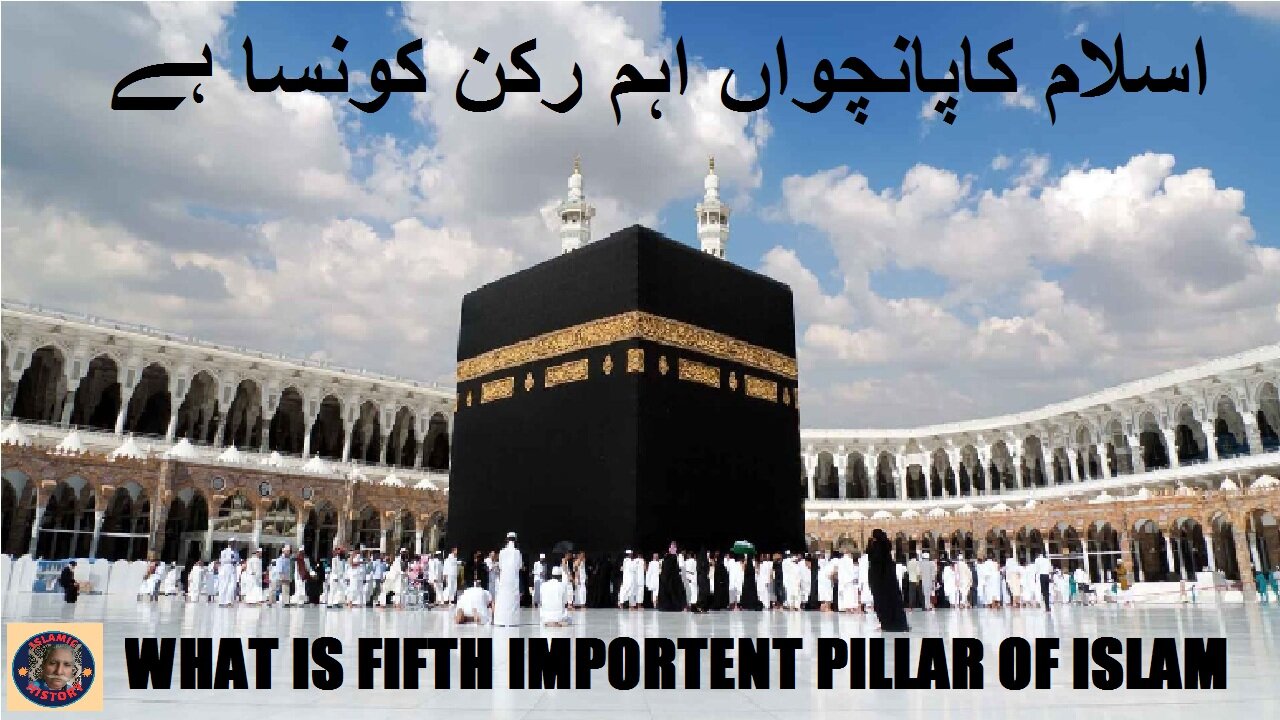Premium Only Content

The Fifth Pillar of Islam Pilgrimage Hajj Explained اسلام کاپانچواں اہم رکن کونسا ہے
#Hajj #Islam #Pilgrimage #Mecca #Muslim #Pilgrim #Hajj2019 #Kaaba #Hajjexplained #Muslims #Islamic #Umrah #Hajjmubarak #Islamicpilgrimage #Hajjrituals #Muslimcommunity #Makkah #Hajjjourney #Hajjtraditions #faithful
Fifth Pillar: Hajj (Pilgrimage)
Main article: Hajj
Asslamoalaikum, sisters, brother, friends and elders today we are discribing 5th pillar of Islam?
Hajj is the sacred pilgrimage performed by Muslims at the holy mosque of Masjid al-Haram in Makkah, Saudi Arabia. It is one of the five pillars of Islam, which means that it is obliged of every Muslim at least once in their lifetime (so long as they have the means). Hajj takes place during the same period each year – during the month of Dhul Hijjah, the twelfth month in the Islamic Calendar. Hajj begins on the 8th of Dhul Hijjah and lasts until the 13th of Dhul Hijjah.
This year, Hajj is taking place between 14th June to the 19th June 2024 in the Gregorian Calendar.
The Islamic calendar operates on the lunar cycle, which is why it appears to shift forward approximately 11-12 days each year as it corresponds to the Gregorian calendar.
As Muslims, undertaking Hajj in Islam – is a spiritual duty, as long as we are financially, physically, and emotionally able to do so.
In the Holy Qur’an, Allah (SWT) commands Muslims to take this sacred journey:
You will enter the Sacred Masjid, God willing, perfectly secure, and you will cut your hair or shorten it (as you fulfil the pilgrimage rituals) there. You will not have any fear. Since He knew what you did not know, He has coupled this with an immediate victory.
Qur’an | 48:27
While it is only required of Muslims to perform the Hajj at least once in their lifetimes, it can be performed multiple times.
How Long Does Hajj Last?
The Hajj pilgrimage is performed over five to six days, from the 8th to 12th or 13th of Dhul Hijjah. When the new crescent moon is sighted, Eid al-Adha begins, which lasts for four days.
The pilgrimage is comprised of a series of rites and rituals, some of which must be performed in order. It can be physically demanding, as pilgrims are required to travel between locations throughout, and can walk on average between 5km-15km per day. Performing Hajj is a test of patience and temperament – it is a spiritual, emotional, and physical challenge, it can take some preparation and for many, it is a once in a lifetime event.
However, it offers Muslims the opportunity to refresh their spiritual selves, to cleanse them of their sins and draw closer to Allah (SWT).
You can access everything you need to know about Hajj and what it entails here.
Does Hajj Occur On The Same Dates Every Year?
Yes, Hajj takes place between the same dates each year. Hajj takes place between the 8th and the 12th or 13th of Dhul Hijjah each year, depending on the sighting of the moon.
Dhul Hijjah is the twelfth month in the Islamic calendar and holds some of the most sacred periods of the entire Islamic calendar. Dates in the Islamic calendar appear to shift forward approximately 11-12 days as it corresponds to the Gregorian calendar, as the Islamic Calendar operates on the lunar cycle.
Hajj consists of its own unique rites and rituals but does share some similarities with the rites and rituals of Umrah. Umrah is a voluntary pilgrimage, which can be performed during any time of the year.
Where Does The Hajj Take Place?
Hajj is performed in Makkah, modern day Saudi Arabia. The pilgrimage consists of a series of rites and rituals across five to six days and is performed across several locations within the vicinity of Makkah.
These locations include:
The city of Makkah
The tent settlement of Mina
Mount ‘Arafah
Muzdalifah
Who Is Excluded From Hajj?
It is required of every Muslim to perform Hajj at least once in their lifetime. However, the Hajj is not intended as a burden upon Muslims, and Muslims are only required to perform Hajj so long as it is within their capacity.
Those who are exempt from Hajj are the following:
Firstly, only Muslim adults (whether male or female) are required to perform Hajj. This means that while children may go to Hajj, it is not required of them.
Secondly, the very weak, sick, elderly, or otherwise physically incapable Muslims are exempt from having to perform the pilgrimage.
Thirdly, the Muslim must be financially able to perform Hajj. However, if one is in debt, they may still perform Hajj as long as:
The creditor permits it
The debtor has time to pay off the debt
Hajj does not affect their ability to pay off the debt
Read our Hajj facts for everything you need to know about Hajj.
Brief History Of The Hajj
In 628 CE, the Prophet Muhammad (peace and blessings be upon him) and the Muslims embarked on the first Islamic Pilgrimage (Hajj), re-establishing the traditions started by the Prophet Ibrahim (AS), who first began the tradition of Hajj millennia before.
The story of Hajj begins with the story of Ibrahim (AS) and the commandment of Allah (SWT) to travel to the barren desert of Makkah and leave his wife Hajar and infant son Ismail (AS). They followed the commandment of Allah (SWT).
Hajar and Ismail (AS) quickly ran out of resources, and in a desperate effort to find water, Hajar ran between the two neighbouring hills of Safa and Marwa in search of someone who could help or nearby water. She did this seven times, only to return to a crying Ismail (AS) empty handed.
As the infant baby cried, Ismail (AS) struck the ground with his leg, and a stream of water burst forth at the commandment of Allah (SWT). This stream of water relieved the pair of their thirst and became a resource with which they traded for provisions of all kinds with travelling merchants. This stream of water is known today as the well of Zam Zam.
Ibrahim (AS) was commanded to return to his family years later, only to find the miracle of his family alive and indeed thriving. The pitch that had started with Hajar and Ismail (AS) was now transforming into a thriving settlement that would become known as Makkah.
Ibrahim (AS) was then instructed by Allah (SWT) to mark the space with a stone structure known as the Kaaba. Ibrahim (AS) built it with his son Ismail (AS), in the exact same spot it was first built by the first man and prophet of Allah (SWT), Adam (AS).
The space was created for worshippers of the one God to gather, and the stone structure known as the Kaaba simply marks the spot where Muslims unite. It is not something that is worshipped, as idolatry is prohibited in Islam.
Over time, the Kaaba would be taken over by pagan Arabs, who filled it with idols.
Thousands of years later, when the Prophet Muhammad (peace and blessings be upon him) was given revelation and the final message of Tawheed (monotheism), he was instructed to reinstate Ibrahim’s (AS) sacred tradition– the sacred pilgrimage we know as Hajj today.
You can read this story in detail, as well as the significance of Qurbani and more in our comprehensive Hajj guide.
When Did The First Hajj Pilgrimage Take Place?
Hajj as we know it today was first performed in 628 CE, by the Prophet Muhammad (peace and blessings be upon him) and the Muslims. He (peace and blessings be upon him) was instructed to re-establish the traditions started by the Prophet Ibrahim (AS) as instructed by Allah (SWT), millennia before.
The Hajj pilgrimage is performed over five to six days, from the 8th to 12th or 13th of Dhul Hijjah. When the new crescent moon is sighted, Eid al-Adha begins, which lasts for four days.
Firstly, only Muslim adults (whether male or female) are required to perform Hajj. This means that, while children may go to Hajj, it is not required of them.
Secondly, the very weak, sick, elderly, or otherwise physically incapable Muslims are exempt from having to perform the pilgrimage.
Thirdly, the Muslim must be financially able to perform Hajj.
We pray to Allah almighty to give us permission to perform pilgrimage. Ameen Allah hafiz
-
 7:59
7:59
ISLAMIC HISTORY
2 days agoSheikh Adibali and history of his shrine شیخ ادیبالی کی سوانح عمری اور ان کے مزار کی تاریخ
6 -
 1:21:36
1:21:36
Michael Franzese
21 hours agoSuge Knight Speaks On Diddy, Trump's Pardons, and the Biden's Lies… | LIVE
102K35 -
 1:16:59
1:16:59
T-SPLY
5 hours agoJudge And Protesters Try to Stop ICE Arrest In Court Hallway!
18.8K34 -
 LIVE
LIVE
Grant Cardone
4 hours agoWEALTHCON by GRANT CARDONE DAY 1
974 watching -
 LIVE
LIVE
Joker Effect
1 hour agoFIRST EVER AMATEUR BOXING EVENT STREAMED ON RUMBLE! BOUGHT TO YOU BY WOLFSDEN BOXING!
1,618 watching -
 39:20
39:20
Rethinking the Dollar
1 hour agoTechnocratic World Order: Elon Steps Aside As Palantir Steps In | RTD News Update
7.08K8 -
 52:39
52:39
vivafrei
4 hours agoA Soldier's Journey Home: Sergeant First Class New Home Reveal LIVE!
49.3K6 -
 LIVE
LIVE
Major League Fishing
1 day agoLIVE MLF BFL All-American Championship!
1,594 watching -
![🔴 Live - [ 36 Hr Marathon ]](https://1a-1791.com/video/fww1/7d/s8/1/z/G/-/O/zG-Oy.0kob-small--Live-36-Hr-Marathon-.jpg) LIVE
LIVE
Delnorin Games
4 hours ago🔴 Live - [ 36 Hr Marathon ]
128 watching -
 LIVE
LIVE
Total Horse Channel
17 hours ago2025 Buckeye Reining Spectacular - Saturday
75 watching